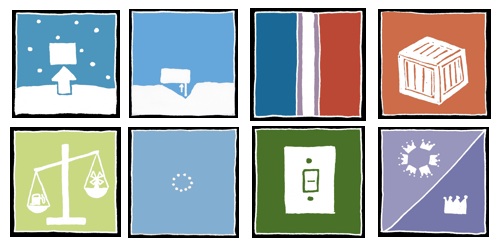Cabin Fever is a severe form of depression that affects people during the winter months and causes inactivity, weight gain, social withdrawal and sleep disturbance. This type of depression is brought on by factors such as severe winter storms, confined spaces and boredom. Also, the lack of sunlight can contribute to the human psyche by causing a chemical imbalance in the brain. This is due to the fact that when serotonin is not released in a sufficient quantity it can lead to depression, which is what can occur in isolated communities such as the Amundsen's Fram and the Amundsen-Scott South Pole Station.
Therefore, the design of both of these structures becomes important to prevent this illness from occurring.
Amundsen’s Fram:
In the Amundsen's Fram, cabin fever was prevented by designing all the common areas to be open to all members for social interaction. Also, in this areas entertainment gatherings were held where a game of cards was played or music was played. Lastly, access to the deck allowed for sunlight to provide natural light to the ship.

A Whist-Party in the Saloon at the Fram
Amundsen-Scott South Pole Station:
- 1956 Station
The 1956 station was built underground, which allowed no access to natural sunlight and the only light source was artificial lighting. Also, it was designed as a work station, without accommodating members' needs in such an isolated location. Therefore, only recreation had to be done in the dining area or outside. However, recreation was similar as in the Fram where simple games were played, along with music and reading.

1958 Thanksgiving Dinner
- Dome Station
The dome station was also built underground but it took some new approaches to solve the cabin fever effects. Even though the station was built underground, the dome was meant to be above ground, which allowed for limited sunlight to penetrate the building. However, throughout many winters the dome was covered in snow, which did not allow for light to come in during the summer. Lastly, there were limited areas for recreation but to pass the time the crew members would play music and cards, and created a pass time of dome sliding.

Dome Sliding
- New Station
The new station is the best facility that meets the needs to prevent cabin fever because the design integrated new innovative ways to withstand the harsh climate at the south pole. The fact that this station is elevated, allows for windows to be incorporated to allow sunlight access during the summer months. In addition, it offers new recreation rooms such as a Gym, exercise room, activity/band room, growing chamber, arts and crafts room, sauna, bar, t.v. lounge and game room, etc, to eliminate inactivity. Lastly, during the dark winter months when sunlight is not available, UV lighting has been included to simulate the sunlight.


No comments:
Post a Comment